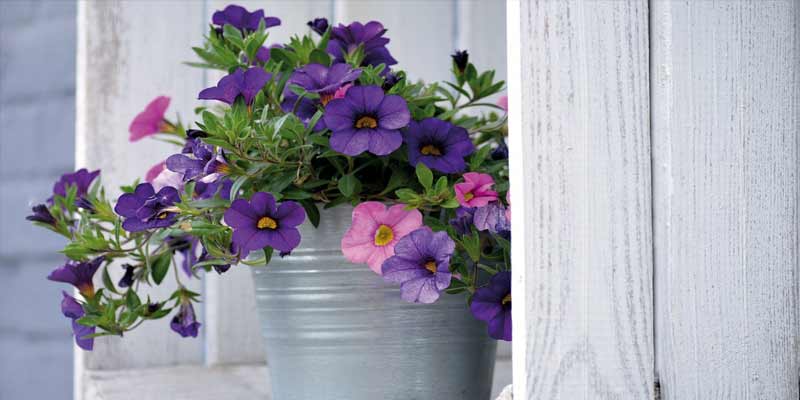Beloved for their ability to infuse outdoor spaces with charm and beauty, petunias boast vibrant colors and prolific blooms. Garden beds, hanging baskets, or containers – in any location these versatile annuals adorn; they captivate with their colorful displays and delightful fragrance.
Many gardeners opt for the convenience and flexibility of growing petunias in pots as it allows them an up-close appreciation of their beauty. Understanding the longevity of petunias in pots and the factors that influence it is crucial for plant health and thriving.
This article delves into three main aspects: exploring petunia lifespan in containers; maximizing their longevity with valuable tips, and strategizing to ensure consistent robustness and vigor of these plants.
Understanding the Lifespan of Petunias in Pots
Various factors, such as environmental conditions, care practices, and the specific needs of petunias determine how long they will last in pots. Petunias typically bloom from spring until fall’s first frost as warm-season annuals with a lifespan spanning several months. If cultivated in containers instead of garden beds, petunias might demonstrate slightly different growth patterns and requirements.
5 Factors Influencing the Lifespan of Petunias in Pots
Several key factors influence the duration that petunias thrive and bloom in pots:
1. Size and Type of Container
The size and type of container utilized for petunia cultivation significantly impact their longevity and overall health. Larger containers, by offering ample space for root expansion as well as enhanced moisture retention, promote the growth of robustly healthy petunias over extended periods. Choose containers with adequate drainage holes to prevent waterlogging and root rot.
2. Potting Mix and Soil Quality
High-quality potting mix with good drainage and aeration is crucial for container-grown petunias; the soil quality plays a significant role in their growth. The potting mix should possess excellent draining capabilities while remaining lightweight, thereby enabling the free discharge of surplus water yet preserving moisture for absorption by the plant.
Steer clear of employing dense garden soil; its compaction and root suffocation can result in stunted growth, ultimately reducing the lifespan.
3. Watering Practices
The health and longevity of potted petunias hinge critically on proper watering. When you perceive that the top inch of soil feels dry to your touch, ensure thorough watering; this step guarantees water penetration into the root zone, a vital process for optimal plant growth and vitality.
Regularly monitor the soil moisture to prevent overwatering; indeed, excessively damp soil may instigate root rot and other complications related to moisture. Adjust the frequency of watering: base it on both environmental conditions such as rainfall or humidity levels, and the specific needs of your plants.
4. Sunlight Exposure
Petunias thrive in full sunlight, these flowers necessitate a minimum of 6-8 hours per day of direct exposure to the sun for their optimal growth and flowering; thus place your containers in locations replete with ample sunlight throughout the day – be it patios, balconies or windowsills.
Leggy growth and reduced flowering: these are the potential consequences of insufficient sunlight. Such conditions may significantly impact a plant’s overall lifespan.
5. Temperature and Climate
Petunias thrive in moderate climates and prefer warm temperatures, specifically in USDA hardiness zones 9-11. Shielding petunias from extreme heat or cold is essential, provide shade during the peak of the day for protection against scorching temperatures; bring containers of petunias indoors when frost or freezing conditions prevail to maintain their optimal growth.
Harsh weather conditions can abbreviate the lifespan of petunias, undermining their health and vigor.
6 Tips for Maximizing the Lifespan of Petunias in Pots
Consider the following tips to maximize the longevity and profuse blooming of petunias in pots:
1. Choose the Right Varieties:
Select petunia varieties known for their longevity and performance in containers; specifically, compact or dwarf options like ‘Milliflora’ or ‘Calibrachoa’ are commendable choices due to their suitability for pot culture. These particular selections guarantee a continuous bloom throughout the season.
2. Provide Adequate Nutrition
Regularly feed container-grown petunias with a balanced liquid fertilizer to provide essential nutrients for growth and flowering: this ensures adequate nutrition.
However, be cautious in the application of your fertilizers; adhere strictly to package instructions, as an excess of nitrogen can promote lavish foliage at the cost of blooms.
3. Deadhead Spent Flowers
Regularly remove faded or spent flowers to stimulate continuous blooming; this prevents seed formation. By redirecting the plant’s energy into producing new blooms – a process known as deadheading – we can prolong its flowering period and enhance overall plant aesthetics.
4. Maintenance Pruning
To maintain their shape, petunias require periodic pruning; this process eliminates leggy growth and promotes bushy, compact habits. By trimming back the stems and foliage – an action that encourages branching while stimulating fresh growth – we rejuvenate these plants, thereby extending their lifespan.
5. Monitor for Pests and Diseases
Vigilantly observe the petunias for potential pest or disease-related indicators, such as aphids; spider mites; or fungal infections. Swiftly address infestations with either insecticidal soap, or horticultural oil, and ensure adequate airflow and spacing—this will lower the risk of disease transmission.
6. Rotate Containers
Periodically rotate your containers to guarantee that petunias enjoy uniform sunlight exposure and deter any potential uneven growth or inclination towards the light source. Ensure you rotate these containers every few weeks; this will foster a balanced development, promoting flowering on all sides of your plants.
Renewing Petunias for Extended Lifespan
Despite the meticulous care and maintenance: after several months of growth, petunias may exhibit a decline, particularly those planted in containers. To rejuvenate these flowers; to extend their lifespan – here are some recommended strategies for renewal:
Refresh Potting Mix
Periodically, refresh the potting mix in your containers; this action replenishes nutrients and enhances soil structure. Here’s how: remove that top layer of aged potting material – and replace it with fresh, nutrient-rich soil. In doing so, you provide petunias with a renewed growing medium, an ideal habitat for their flourishing growth.
Trim and Prune
To rejuvenate petunias and stimulate new growth, trim back overgrown or leggy stems; prune away dead or diseased foliage. Employ clean, sharp pruning shears for precise cuts, this will encourage healthy regrowth.
Divide and Repot
Should petunias overcrowd or become root-bound in containers, one should divide the root ball and transplant individual plants into larger pots. This practice enables petunias to spread out; it also provides access to fresh soil – a crucial source of nutrients. The result? Vigorous growth and blooming are promoted with this approach.
Provide Winter Protection
In regions with cold winters, you must protect container-grown petunias from the detrimental effects of frost and freezing temperatures. Either bring them indoors or provide shelter in locations like garages or covered porches.
By overwintering petunias indoors, not only can you extend their lifespan but also ensure a vigorous return in the subsequent growing season.
Conclusion
Understanding the factors that influence petunias’ lifespan in containers and implementing proper care and maintenance practices can allow gardeners to maximize their longevity; this provides captivating displays throughout the growing season. With attention dedicated to watering, nutrition, pruning, as well as renewal container-grown petunias thrive. They continue brightening gardens with enduring charm and an abundance of floral beauty on balconies or patios.



Leave a Reply